Satas D., Tracton A.A. (ed.). Coatings Technology Handbook
Подождите немного. Документ загружается.

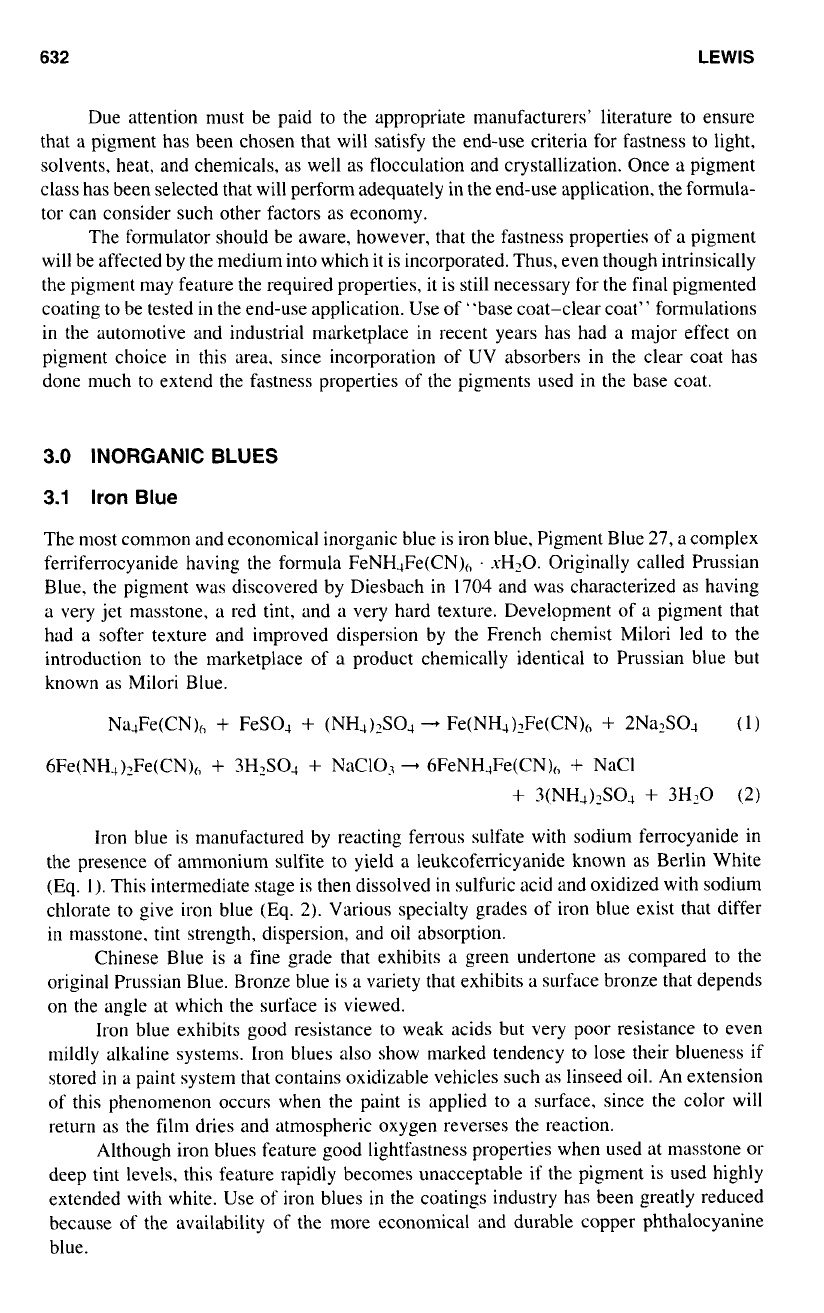
632
Due attention must be paid
to
the appropriate manufacturers’ literature
to
ensure
that a pigment has been chosen that will satisfy the end-use criteria for fastness
to
light,
solvents, heat. and chemicals,
as
well as flocculation and crystallization. Once a pigment
class has been selected that will perform adequately in the end-use application. the formula-
tor can consider such other factors as economy.
The formulator should be aware, however, that the fastness properties of a pigment
will be affected by the medium into which it is incorporated. Thus, even though intrinsically
the pigment may feature the required properties, it is still necessary for the final pigmented
coating to be tested in the end-use application. Use
of
“base coat-clear coat” formulations
in
the automotive and industrial marketplace in recent years has had a major effect on
pigment choice in this area. since incorporation of UV absorbers in the clear coat has
done much
to
extend the fastness properties of the pigments used in the base coat.
3.0
INORGANIC
BLUES
3.1
Iron
Blue
The most common and economical inorganic blue is iron blue, Pigment Blue 27, a complex
ferriferrocyanide having the formula FeNH4Fe(CN)(,
.
sH20. Originally called Prussian
Blue. the pigment was discovered by Diesbach
in
1704
and was characterized as having
a very jet masstone, a red tint, and a very hard texture. Development
of
a pigment that
had a softer texture and improved dispersion by the French chemist Milori led
to
the
introduction
to
the marketplace of a product chemically identical
to
Prussian blue but
known as Milori Blue.
Na,Fe(CN),
+
FeSO,
+
(NH4)?S04
-
Fe(NH.,)?Fe(CN),
+
2Na2S04
(1)
6Fe(NH4):Fe(CN)(,
+
3H2S0,
+
NaCIOz
-
6FeNH4Fe(CN),
+
NaCl
+
3(NHJ):SOJ
+
3H2O
(2)
Iron blue
is
manufactured by reacting fenous sulfate with sodium ferrocyanide in
the presence of ammonium sulfite
to
yield a leukcoferricyanide known as Berlin White
(Eq.
l).
This intermediate stage is then dissolved in sulfuric acid and oxidized with sodium
chlorate
to
give iron blue
(Eq.
2). Various specialty grades of iron blue exist that differ
in masstone, tint strength, dispersion, and oil absorption.
Chinese Blue is a fine grade that exhibits a green undertone
as
compared to the
original Prussian Blue. Bronze blue
is
a variety that exhibits a surface bronze that depends
on the angle at which the surface is viewed.
Iron blue exhibits good resistance
to
weak acids but very poor resistance
to
even
mildly alkaline systems. Iron blues also show marked tendency
to
lose their blueness if
stored
in
a paint system that contains oxidizable vehicles such as linseed
oil.
An extension
of this phenomenon occurs when the paint is applied
to
a surface, since the color will
return as the film dries and atmospheric oxygen reverses the reaction.
Although iron blues feature good lightfastness properties when used at nmstone or
deep tint levels. this feature rapidly becomes unacceptable if the pigment is used highly
extended with white. Use
of
iron blues in the coatings industry has been greatly reduced
because of the availability
of
the more economical and durable copper phthalocyanine
blue.
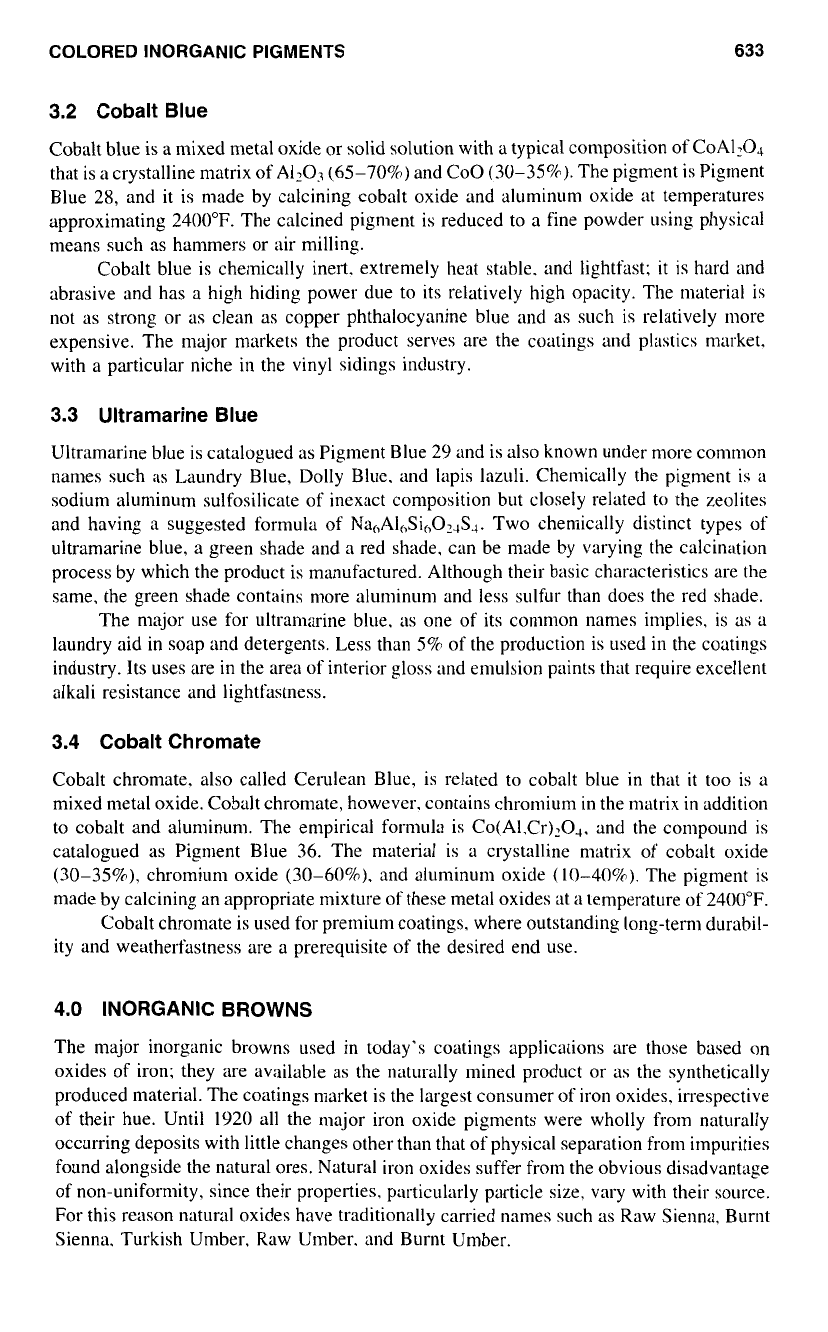
COLORED INORGANIC PIGMENTS
633
3.2 Cobalt Blue
Cobalt blue is a mixed metal oxide or solid solution with a typical composition of CoAl104
that is
a
crystalline matrix
of
Al2O3
(65-70%)
and COO
(30-35%).
The pigment is Pigment
Blue
28,
and it is made by calcining cobalt oxide and aluminum oxide
at
temperatures
approximating 2400°F. The calcined pigment is reduced to a fine powder using physical
means such as hammers or air milling.
Cobalt blue is chemically inert. extremely heat stable. and lightfast;
it
is hard and
abrasive and has a high hiding power due
to
its relatively high opacity. The material is
not as strong or
as
clean as copper phthalocyanine blue and as such is relatively more
expensive. The major markets the product serves are the coatings and plastics market.
with a particular niche
in
the vinyl sidings industry.
3.3 Ultramarine Blue
Ultramarine blue is catalogued as Pigment Blue 29 and is also known under more common
names such as Laundry Blue, Dolly Blue. and lapis lazuli. Chemically the pigment is
a
sodium aluminum sulfosilicate of inexact composition but closely related to the zeolites
and having a suggested formula
of
NahAlhSihOIJS1. Two chemically distinct types of
ultramarine blue, a green shade and a red shade, can be made by varying the calcination
process by which the product is manufactured. Although their basic characteristics are the
same, the green shade contains more aluminum and less sulfur than does the red shade.
The major use for ultramarine blue,
as
one of its common names implies, is as a
laundry aid
in
soap and detergents. Less than
5%
of the production is used
in
the coatings
industry. Its uses are in the area of interior gloss and emulsion paints that require excellent
alkali resistance and lightfastness.
3.4 Cobalt Chromate
Cobalt chromate. also called Cerulean Blue, is related to cobalt blue in that
it
too is
a
mixed metal oxide. Cobalt chromate, however. contains chromium
in
the matrix
in
addition
to cobalt and aluminum. The empirical formula is Co(AI.Cr)204. and the compound is
catalogued as Pigment Blue
36.
The material is a crystalline matrix of cobalt oxide
(30-35%),
chromium oxide
(30-60%).
and aluminum oxide (10-40%). The pigment is
made by calcining an appropriate mixture of these metal oxides at
a
temperature of 2400°F.
Cobalt chromate is used for premium coatings. where outstanding long-term durabil-
ity and weatherfastness are a prerequisite
of
the desired end use.
4.0 INORGANIC BROWNS
The major inorganic browns used in today's coatings applications are those based on
oxides of iron; they are available as the naturally mined product or
as
the synthetically
produced material. The coatings market is the largest consumer of iron oxides. irrespective
of their hue. Until
1920
all the major iron oxide pigments were wholly from naturally
occurring deposits with little changes other than that of physical separation from impurities
found alongside the natural ores. Natural iron oxides suffer from the obvious disadvantage
of
non-uniformity. since their properties, particularly particle size, vary with their source.
For this reason natural oxides have traditionally carried names such as Raw Sienna. Burnt
Sienna. Turkish Umber, Raw Umber, and Burnt Umber.
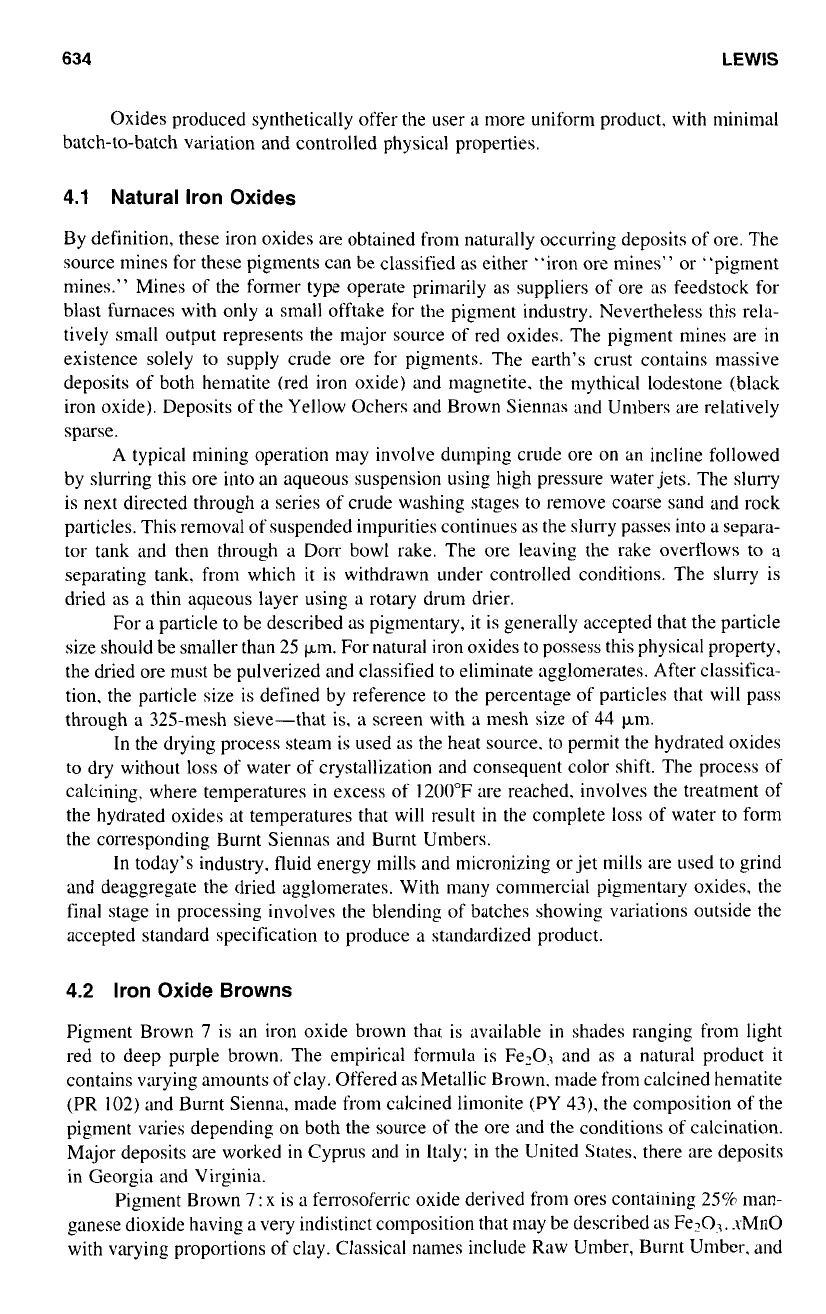
634
LEWIS
Oxides produced synthetically offer the user a more uniform product, with minitnal
batch-to-batch variation and controlled physical properties.
4.1
Natural iron
Oxides
By definition, these iron oxides are obtained from naturally occurring deposits of ore. The
source mines for these pigments can be classified as either “iron ore mines” or “pigment
mines.” Mines of the former type operate primarily as suppliers of ore
as
feedstock for
blast furnaces with only
a
small offtake for the pigment industry. Nevertheless this rela-
tively small output represents the major source of red oxides. The pigment mines are
in
existence solely to supply crude ore for pigments. The earth’s crust contains massive
deposits of both hematite (red iron oxide) and magnetite. the mythical lodestone (black
iron oxide). Deposits of the Yellow Ochers and Brown Siennas and Umbers are relatively
sparse.
A typical mining operation may involve dumping crude ore
on
an incline followed
by slurring this ore
into
an aqueous suspension using high pressure water jets. The slurry
is next directed through a series
of
crude washing stages
to
remove coarse sand and rock
particles. This removal of suspended impurities continues as the slurry passes into a separa-
tor tank and then through a Dorr bowl rake. The ore leaving the rake overflows to a
separating tank, from which
it
is withdrawn under controlled conditions. The slurry is
dried as a thin aqueous layer using a rotary drum drier.
For a particle to be described as pigmentary,
it
is generally accepted that the particle
size should be smaller than 25 km. For natural iron oxides to possess this physical property,
the dried ore must be pulverized and classified to eliminate agglomerates. After classifica-
tion. the particle size is defined by reference to the percentage of particles that will pass
through a 325-mesh sieve-that is. a screen with
a
mesh size of 44 km.
In the drying process steam is used as the heat source, to permit the hydrated oxides
to
dry without loss of water of crystallization and consequent color shift. The process
of
calcining, where temperatures
in
excess
of
1200°F are reached, involves the treatment
of
the hydrated oxides at temperatures that will result in the complete loss of water to form
the corresponding Burnt Siennas and Burnt Umbers.
In
today’s industry. fluid energy mills and micronizing or jet mills are used
to
grind
and deaggregate the dried agglomerates. With many cornmercial pigmentary oxides, the
final stage
in
processing involves the blending of batches showing variations outside the
accepted standard specification
to
produce a standardized product.
4.2
Iron
Oxide
Browns
Pigment Brown
7
is an iron oxide brown that is nvailable
in
shades ranging from light
red to deep purple brown. The empirical formula is Fe203 and as a natural product
it
contains varying amounts of clay. Offered as Metallic Brown. made from calcined hematite
(PR 102) and Burnt Sienna, made from calcined limonite (PY 43). the composition of the
pigment varies depending on both the source of the ore and the conditions of calcination.
Major deposits are worked
in
Cyprus and
in
Italy; in the United States. there are deposits
in Georgia and Virginia.
Pigment Brown
7
:
x
is
a
ferrosoferric oxide derived from ores containing 25% man-
ganese dioxide having a very indistinct composition that may be described
;IS
Fe203. xMnO
with varying proportions of clay. Classical nanles include Raw Umber, Burnt Umber, and
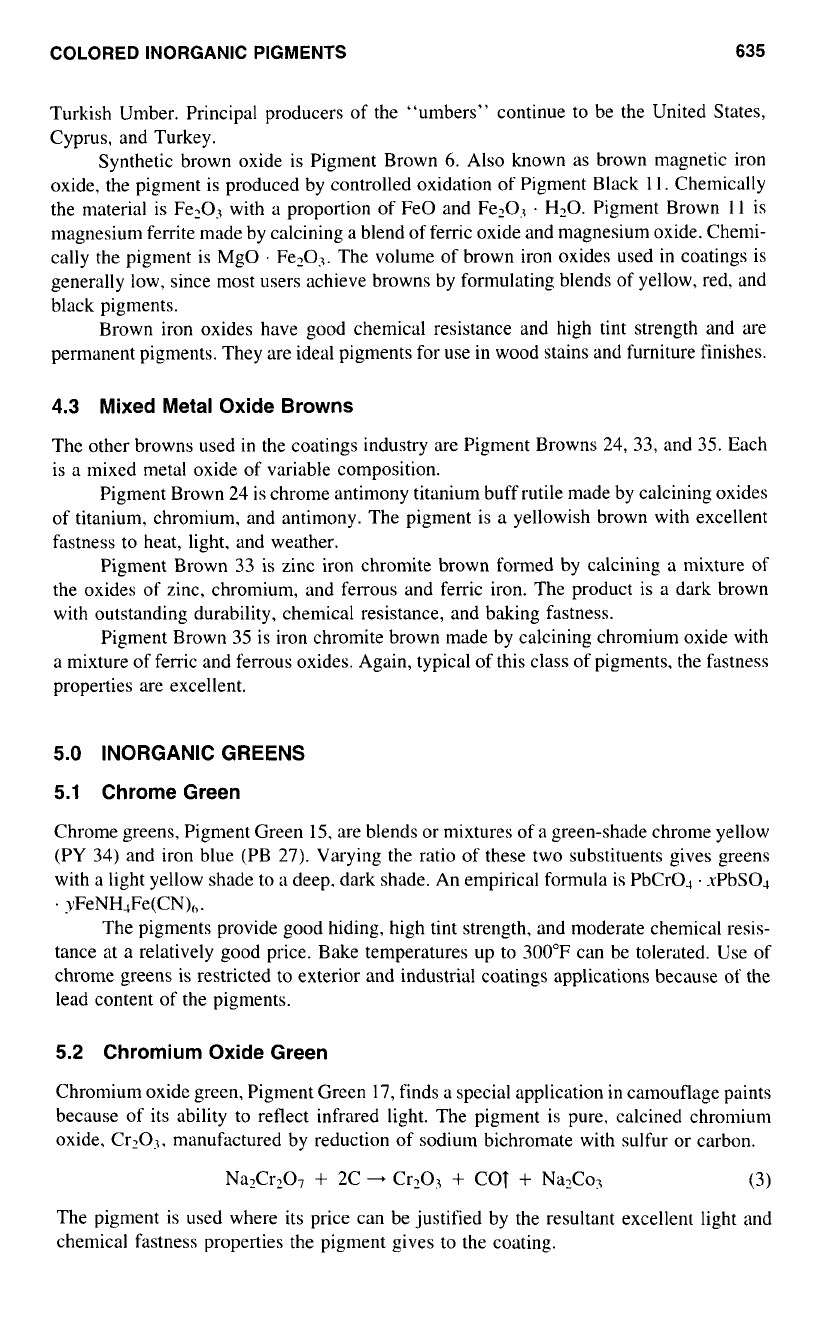
COLORED INORGANIC PIGMENTS
635
Turkish Umber. Principal producers of the “umbers” continue to be the United States,
Cyprus, and Turkey.
Synthetic brown oxide is Pigment Brown
6.
Also known as brown magnetic iron
oxide, the pigment is produced by controlled oxidation of Pigment Black
1
1.
Chemically
the nmerial is Fe203 with a proportion of Fe0 and Fe203
.
HzO.
Pigment Brown
11
is
magnesium ferrite made by calcining a blend
of
ferric oxide and magnesium oxide. Chemi-
cally the pigment is MgO
.
Fe203. The volume of brown iron oxides used in coatings is
generally low, since most users achieve browns by formulating blends of yellow, red. and
black pigments.
Brown iron oxides have good chemical resistance and high tint strength and are
permanent pigments. They are ideal pigments for use in wood stains and furniture finishes.
4.3
Mixed Metal Oxide Browns
The other browns used in the coatings industry are Pigment Browns
24,
33,
and
35.
Each
is a mixed metal oxide of variable composition.
Pigment Brown 24
is
chrome antimony titanium buff rutile made by calcining oxides
of titanium, chromium, and antimony. The pigment is a yellowish brown with excellent
fastness to heat, light. and weather.
Pigment Brown
33
is zinc iron chromite brown formed by calcining
a
mixture
of
the oxides of zinc, chromium, and ferrous and ferric iron. The product is a dark brown
with outstanding durability, chemical resistance, and baking fastness.
Pigment Brown 35 is iron chromite brown made by calcining chromium oxide with
a mixture of ferric and ferrous oxides. Again, typical of this class of pigments, the fastness
properties are excellent.
5.0
INORGANIC GREENS
5.1 Chrome Green
Chrome greens, Pigment Green
15,
are blends or mixtures of a green-shade chrome yellow
(PY 34) and iron blue (PB
27).
Varying the ratio
of
these two substituents gives greens
with a light yellow shade to
a
deep. dark shade. An empirical formula is PbCrOJ
.
xPbS04
.
yFeNH4Fe(CN),.
The pigments provide good hiding, high tint strength, and moderate chemical resis-
tance at a relatively good price. Bake temperatures up to 300°F can be tolerated. Use of
chrome greens is restricted to exterior and industrial coatings applications because of the
lead content of the pigments.
5.2
Chromium Oxide Green
Chromium oxide green, Pigment Green
17,
finds a special application in camouflage paints
because
of
its ability to reflect infrared light. The pigment is pure, calcined chromium
oxide, Cr103. manufactured by reduction of sodium bichromate with sulfur or carbon.
NazCr20,
+
2C
-
Cr203
+
COT
+
Na,Co3 (3)
The pigment is used where its price can be justified by the resultant excellent light and
chemical fastness properties the pigment gives to the coating.
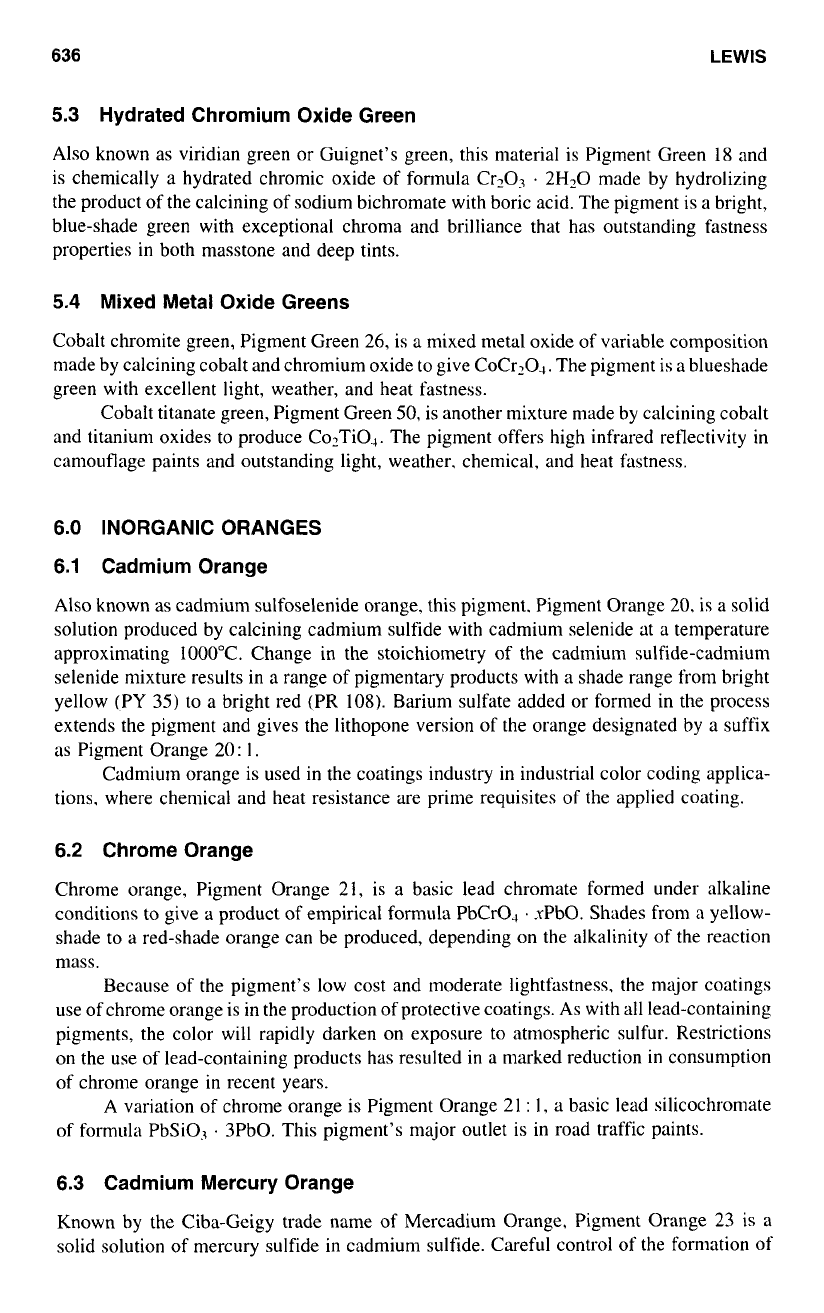
636
LEWIS
5.3
Hydrated Chromium Oxide Green
Also known
as
viridian green or Guignet’s green, this material is Pigment Green 18 and
is chemically a hydrated chromic oxide of formula Cr?03
.
2H20 made by hydrolizing
the product
of
the calcining of sodium bichromate with boric acid. The pigment is
a
bright,
blue-shade green with exceptional chroma and brilliance that has outstanding fastness
properties in both masstone and deep tints.
5.4
Mixed Metal Oxide Greens
Cobalt chromite green, Pigment Green 26, is a mixed metal oxide of variable composition
made by calcining cobalt and chromium oxide to give CoCrz04. The pigment is a blueshade
green with excellent light, weather, and heat fastness.
Cobalt titanate green, Pigment Green 50, is another mixture made by calcining cobalt
and titanium oxides to produce Co2Ti04. The pigment offers high infrared reflectivity in
camouflage paints and outstanding light, weather. chemical, and heat fastness.
6.0
INORGANIC ORANGES
6.1
Cadmium Orange
Also known as cadmium sulfoselenide orange, this pigment. Pigment Orange 20. is a solid
solution produced by calcining cadmium sulfide with cadmium selenide at a temperature
approximating 1000°C. Change in the stoichiometry of the cadmium sulfide-cadmium
selenide mixture results in a range of pigmentary products with a shade range from bright
yellow (PY
35)
to
a
bright red (PR
108).
Barium sulfate added or formed in the process
extends the pigment and gives the lithopone version
of
the orange designated by a suffix
as
Pigment Orange 20:
1.
Cadmium orange is used in the coatings industry in industrial color coding applica-
tions, where chemical and heat resistance are prime requisites of the applied coating.
6.2
Chrome Orange
Chrome orange, Pigment Orange 21, is a basic lead chromate formed under alkaline
conditions to give a product of empirical formula PbCrOJ
.
xPbO. Shades from a yellow-
shade to a red-shade orange can be produced, depending on the alkalinity of the reaction
nms.
Because of the pigment’s low cost and moderate lightfastness, the major coatings
use of chrome orange is in the production of protective coatings. As with all lead-containing
pigments, the color will rapidly darken on exposure to atmospheric sulfur. Restrictions
on the use of lead-containing products has resulted in
a
marked reduction in consumption
of chrome orange
in
recent years.
A variation of chrome orange is Pigment Orange 2
1
:
I,
a basic lead silicochromate
of formula PbSi03
.
3Pb0. This pigment’s major outlet is in road traffic paints.
6.3
Cadmium Mercury Orange
Known by the Ciba-Geigy trade name of Mercadium Orange, Pigment Orange 23 is
a
solid solution
of
mercury sulfide in cadmium sulfide. Careful control
of
the formation
of
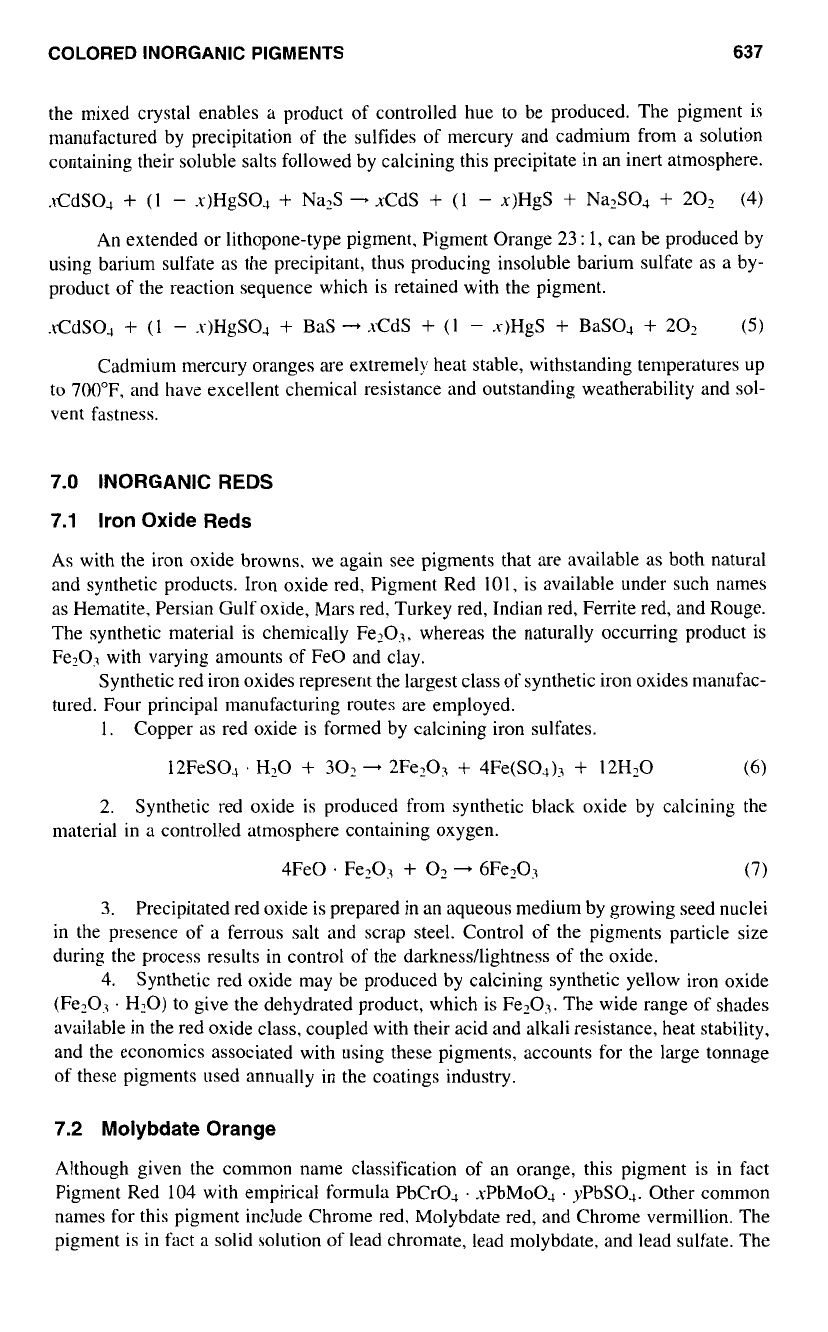
COLORED INORGANIC PIGMENTS
637
the mixed crystal enables a product
of
controlled hue to be produced. The pigment is
manufactured by precipitation of the sulfides of mercury and cadmium from
a
solution
containing their soluble salts followed by calcining this precipitate in an inert atmosphere.
.\-CdS04
+
(1
-
s)HgSO,
+
Na,S
-
sCdS
+
(1
-
x)HgS
+
Na,SO,
+
202 (4)
An extended or lithopone-type pigment, Pigment Orange
23
:
1, can be produced by
using barium sulfate
as
the precipitant, thus producing insoluble barium sulfate as a by-
product
of
the reaction sequence which is retained with the pigment.
.rCdSO,
+
(1
-
.v)HgSO,
+
Bas
-
KdS
+
(1
-
x)HgS
+
BaSO,
+
202
(5)
Cadmium mercury oranges are extremely heat stable, withstanding temperatures up
to 700"F, and have excellent chemical resistance and outstanding weatherability and
sol-
vent fastness.
7.0
INORGANIC
REDS
7.1
Iron Oxide Reds
As with the iron oxide browns. we again see pigments that are available
as
both natural
and synthetic products. Iron oxide red, Pigment Red
101,
is available under such names
as
Hematite, Persian Gulf oxide, Mars red. Turkey red, Indian red, Ferrite red, and Rouge.
The synthetic material is chemically Fe203. whereas the naturally occurring product is
Fe203 with varying amounts
of
Fe0 and clay.
Synthetic red iron oxides represent the largest class
of
synthetic iron oxides manufac-
tured. Four principal manufacturing routes are employed.
1.
Copper as red oxide is formed by calcining iron sulfates.
12FeS04
.
H,O
+
30,
-
2Fe203
+
4Fe(S04h
+
12H20
(6)
2. Synthetic red oxide is produced from synthetic black oxide by calcining the
material in a controlled atmosphere containing oxygen.
4Fe0
.
Fez03
+
O2
-
6Fez03
3.
Precipitated red oxide is prepared in an aqueous medium by growing seed nuclei
in the presence of
a
ferrous salt and scrap steel. Control
of
the pigments particle size
during the process results in control of the darknesdlightness
of
the oxide.
4.
Synthetic red oxide may be produced by calcining synthetic yellow iron oxide
(Fez03
.
H20)
to give the dehydrated product, which is Fe,03. The wide range
of
shades
available in the red oxide class, coupled with their acid and alkali resistance, heat stability,
and the economics associated with using these pigments, accounts for the large tonnage
of these pigments used annually in the coatings industry.
7.2
Molybdate Orange
Although given the common name classification
of
an orange, this pigment is in fact
Pigment Red 104 with empirical formula PbCrO,
.
sPbMo04
.
yPbS04. Other common
names for this pigment include Chrome red, Molybdate red, and Chrome vermillion. The
pigment is in fact a solid solution of lead chromate, lead molybdate, and lead sulfate. The
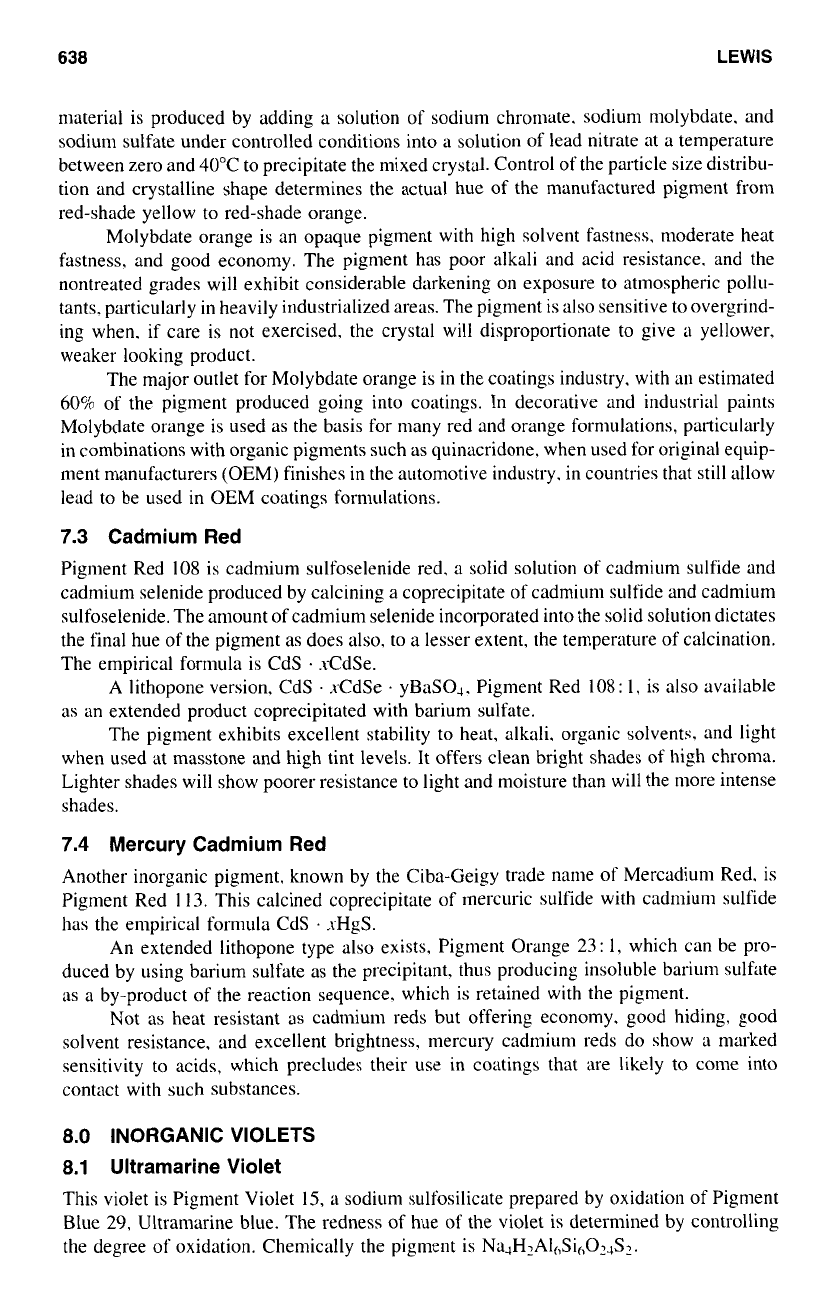
638
LEWIS
material is produced by adding a solution of sodium chromate. sodium molybdate, and
sodium sulfate under controlled conditions into a solution of lead nitrate
at
a temperature
between zero and 40°C to precipitate the mixed crystal. Control of the particle size distribu-
tion and crystalline shape determines the actual hue of the manufactured pigment from
red-shade yellow
to
red-shade orange.
Molybdate orange is an opaque pigment with high solvent fastness. moderate heat
fastness. and good economy. The pigment has poor alkali and acid resistance. and the
nontreated grades will exhibit considerable darkening
on
exposure
to
atmospheric pollu-
tants. particularly
in
heavily industrialized areas. The pigment is also sensitive
to
overgrind-
ing when. if care is not exercised, the crystal will disproportionate to give
a
yellower,
weaker looking product.
The major outlet for Molybdate orange is in the coatings industry. with
an
estimated
60%
of the pigment produced going into coatings. In decorative and industrial paints
Molybdate orange is used as the basis for many red and orange formulations, particularly
in combinations with organic pigments such as quinacridone, when used for original equip-
ment manufacturers
(OEM)
finishes in the automotive industry. in countries that still allow
lead to be used in OEM coatings formulations.
7.3
Cadmium Red
Pigment Red
108
is cadmium sulfoselenide red, a solid solution of cadmium sulfide and
cadnlium selenide produced by calcining a coprecipitate of cadmium sulfide and cadmium
sulfoselenide. The amount of cadmium selenide incorporated
into
the solid solution dictates
the final hue of the pigment as does also, to a lesser extent, the temperature
of
calcination.
The empirical formula is CdS
.
sCdSe.
A lithopone version, CdS
.
xCdSe
.
yBaSO,. Pigment Red
108:
1,
is also available
as an extended product coprecipitated with barium sulfate.
The pigment exhibits excellent stability
to
heat, alkali. organic solvents, and light
when used at masstone and high tint levels.
It
offers clean bright shades of high chroma.
Lighter shades will show poorer resistance
to
light and moisture than will the more intense
shades.
7.4
Mercury Cadmium Red
Another inorganic pigment. known by the Ciba-Geigy trade name
of
Mercadium Red. is
Pigment Red
1
13.
This calcined coprecipitate of mercuric sulfide with cadmium sulfide
has the empirical formula CdS
.
sHgS.
An extended lithopone type also exists, Pigment Orange 23:
1,
which can be pro-
duced by using barium sulfate as the precipitant, thus producing insoluble barium sulfate
as
a by-product of the reaction sequence. which is retained with the pigment.
Not as heat resistant as cadmium reds but offering economy, good hiding. good
solvent resistance, and excellent brightness. mercury cadmium reds do show a marked
sensitivity to acids, which precludes their use in coatings that are likely
to
come into
contact with such substances.
8.0
INORGANIC VIOLETS
8.1
Ultramarine Violet
This violet is Pigment Violet
15,
a
sodium sulfosilicate prepared by oxidation of Pigment
Blue
29,
Ultramarine blue. The redness
of
hue of the violet is determined by controlling
the degree of oxidation. Chemically the pigment is Na4H2AI,Si,,02,S2.
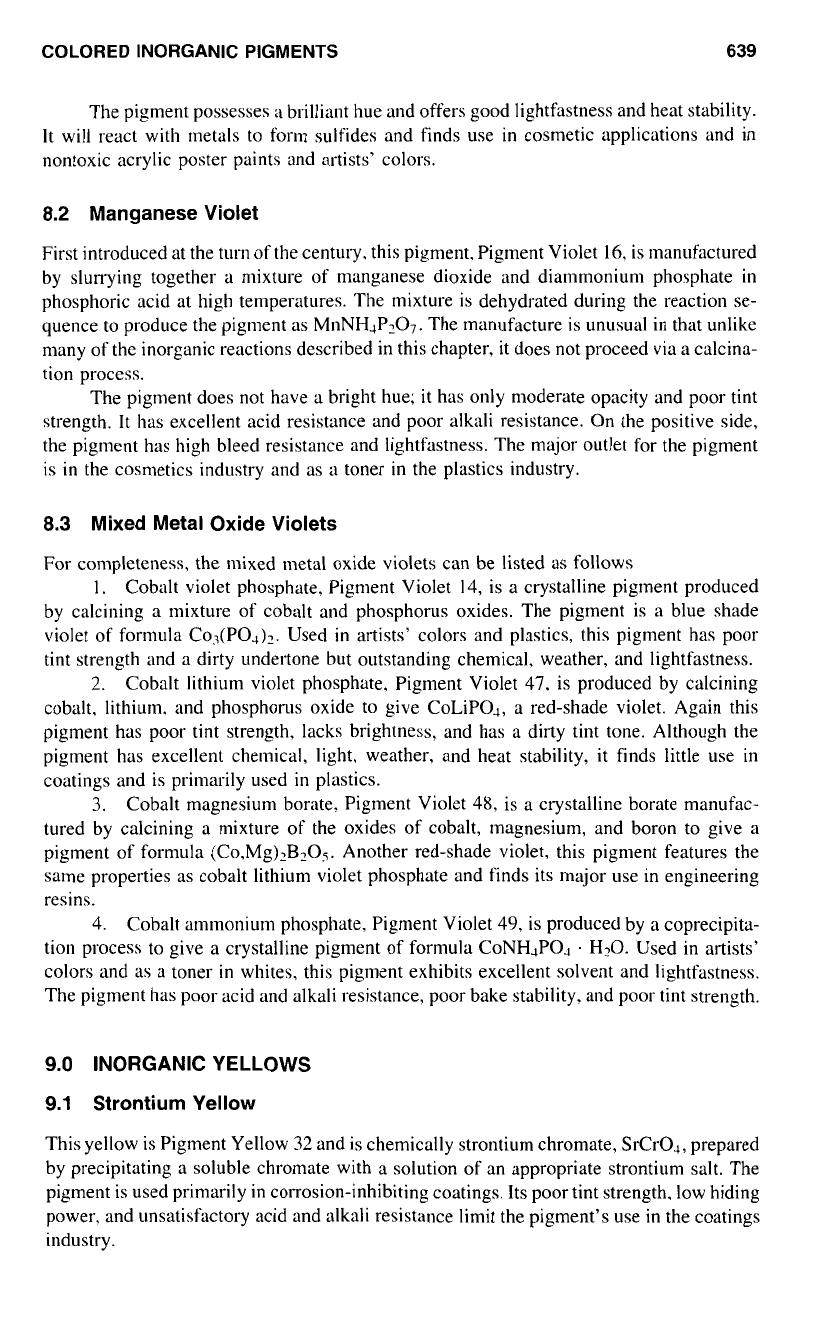
COLORED INORGANIC PIGMENTS
639
The pigment possesses
a
brilliant hue and offers good lightfastness and heat stability.
It
will react with metals to form sulfides and finds use in cosmetic applications and
in
nontoxic acrylic poster paints and artists’ colors.
8.2
Manganese Violet
First introduced at the turn of the century. this pigment, Pigment Violet
16,
is manufactured
by slurtying together a mixture of manganese dioxide and diammonium phosphate
in
phosphoric acid at high temperatures. The mixture is dehydrated during the reaction se-
quence to produce the pigment as MnNH,P,O,. The manufacture is unusual in that unlike
many of the inorganic reactions described in this chapter, it does not proceed via a calcina-
tion process.
The pigment does not have a bright hue;
it
has only moderate opacity and poor tint
strength. It has excellent acid resistance and poor alkali resistance. On the positive side,
the pigment has high bleed resistance and lightfastness. The major outlet for the pigment
is
in
the cosmetics industry and as
a
toner
in
the plastics industry.
8.3
Mixed Metal Oxide Violets
For completeness, the mixed metal oxide violets can be listed as follows
1.
Cobalt violet phosphate, Pigment Violet
14,
is a crystalline pigment produced
by calcining a mixture of cobalt and phosphorus oxides. The pigment is
a
blue shade
violet of formula
Co3(P04),.
Used
in
artists’ colors and plastics, this pigment has poor
tint strength and a dirty undertone but outstanding chemical, weather, and lightfastness.
2.
Cobalt lithium violet phosphate, Pigment Violet
47,
is
produced by calcining
cobalt, lithium. and phosphorus oxide to give CoLiPO,, a red-shade violet. Again this
pigment has poor
tint
strength, lacks brightness, and has a dirty tint tone. Although the
pigment has excellent chemical, light. weather, and heat stability, it finds little use in
coatings and is primarily used
in
plastics.
3.
Cobalt magnesium borate. Pigment Violet
48,
is a crystalline borate manufac-
tured by calcining a mixture
of
the oxides of cobalt, magnesium, and boron to give a
pigment of formula (CO,M~)~B,O~. Another red-shade violet, this pigment features the
same properties as cobalt lithium violet phosphate and finds its major use in engineering
resins.
4.
Cobalt ammonium phosphate, Pigment Violet
49,
is produced by a coprecipita-
tion process to give a crystalline pigment of formula CoNH,PO,
.
H20.
Used in artists’
colors and as a toner
in
whites, this pigment exhibits excellent solvent and lightfastness.
The pigment has poor acid and alkali resistance. poor bake stability. and poor
tint
strength.
9.0
INORGANIC
YELLOWS
9.1
Strontium Yellow
This yellow is Pigment Yellow
32
and is chemically strontium chromate, SrCrO,, prepared
by precipitating a soluble chromate with a solution
of
an appropriate strontium salt. The
pigment is used primarily
in
corrosion-inhibiting coatings. Its
poor
tint strength. low hiding
power, and unsatisfactory acid and alkali resistance limit the pigment’s use
in
the coatings
industry.
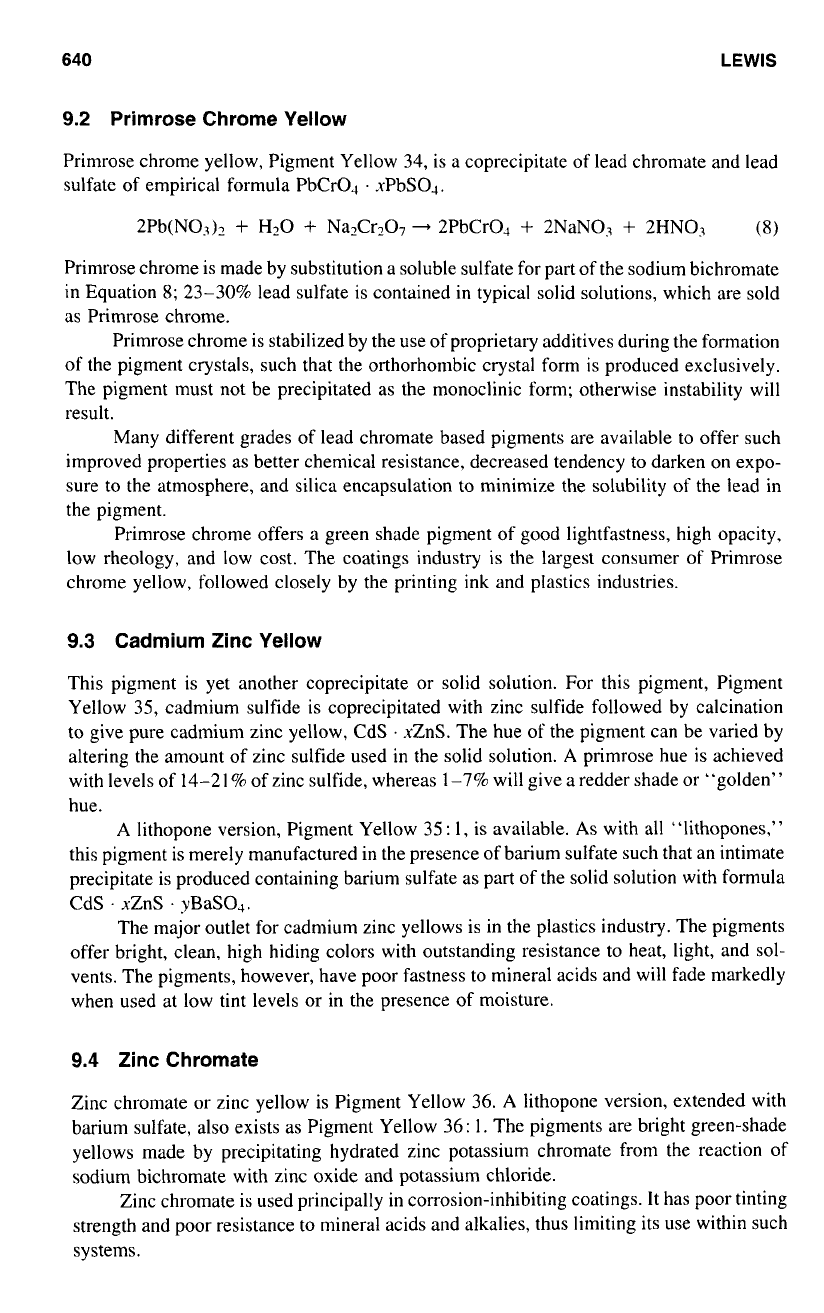
640
LEWIS
9.2
Primrose Chrome
Yellow
Primrose chrome yellow, Pigment Yellow 34, is a coprecipitate of lead chromate and lead
sulfate
of
empirical formula PbCrOJ
.
xPbS0,.
2Pb(N03),
+
HzO
+
NazCrz07
-
2PbCr04
+
2NaN03
+
2HN03
(8)
Primrose chrome is made by substitution
a
soluble sulfate for part
of
the sodium bichromate
in Equation
8;
23-30% lead sulfate is contained in typical solid solutions, which are sold
as
Primrose chrome.
Primrose chrome is stabilized by the use of proprietary additives during the formation
of
the pigment crystals, such that the orthorhombic crystal form is produced exclusively.
The pigment must not be precipitated
as
the monoclinic form; otherwise instability will
result.
Many different grades of lead chromate based pigments are available to offer such
improved properties as better chemical resistance, decreased tendency
to
darken on expo-
sure to the atmosphere, and silica encapsulation to minimize the solubility
of
the lead in
the pigment.
Primrose chrome offers a green shade pigment
of
good lightfastness, high opacity,
low rheology, and low cost. The coatings industry is the largest consumer of Primrose
chrome yellow, followed closely by the printing ink and plastics industries.
9.3
Cadmium Zinc
Yellow
This pigment is yet another coprecipitate or solid solution. For this pigment, Pigment
Yellow 35, cadmium sulfide is coprecipitated with zinc sulfide followed by calcination
to give pure cadmium zinc yellow, CdS
.
xZnS. The hue of the pigment can be varied by
altering the amount of zinc sulfide used in the solid solution.
A
primrose hue is achieved
with levels of 14-21
%
of
zinc sulfide, whereas
1-7%
will give a redder shade or “golden”
hue.
A
lithopone version, Pigment Yellow
35
:
1,
is available.
As
with all “lithopones,”
this pigment is merely manufactured in the presence of barium sulfate such that an intimate
precipitate is produced containing barium sulfate
as
part of the solid solution with formula
CdS
.
xZnS
.
yBaSOJ.
The major outlet for cadmium zinc yellows is in the plastics industry. The pigments
offer bright, clean, high hiding colors with outstanding resistance to heat, light, and
sol-
vents. The pigments, however, have poor fastness to mineral acids and will fade markedly
when used at low tint levels or in the presence of moisture.
9.4
Zinc Chromate
Zinc chromate or zinc yellow is Pigment Yellow 36.
A
lithopone version, extended with
barium sulfate, also exists as Pigment Yellow 36
:
1.
The pigments are bright green-shade
yellows made by precipitating hydrated zinc potassium chromate from the reaction of
sodium bichromate with zinc oxide and potassium chloride.
Zinc chromate is used principally in corrosion-inhibiting coatings. It has poor tinting
strength and poor resistance
to
mineral acids and alkalies, thus limiting its use within such
systems.
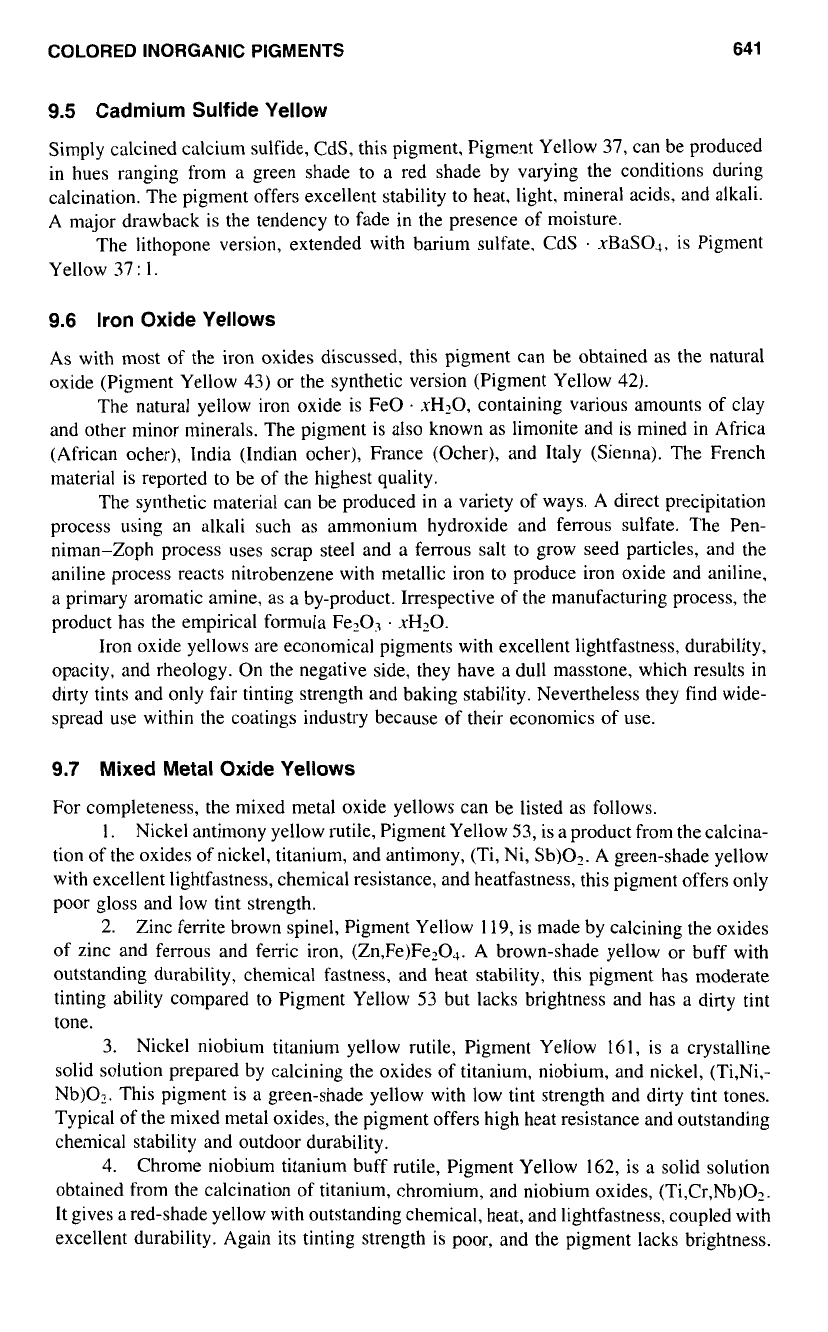
COLORED INORGANIC PIGMENTS
641
9.5
Cadmium Sulfide Yellow
Simply calcined calcium sulfide, CdS, this pigment, Pigment Yellow
37,
can be produced
in hues ranging from a green shade to a red shade by varying the conditions during
calcination. The pigment offers excellent stability to heat, light. mineral acids, and alkali.
A major drawback is the tendency
to
fade in the presence
of
moisture.
The lithopone version, extended with barium sulfate. CdS
.
xBaS04, is Pigment
Yellow
37
:
1.
9.6
Iron
Oxide Yellows
As with most
of
the iron oxides discussed, this pigment can be obtained as the natural
oxide (Pigment Yellow 43) or the synthetic version (Pigment Yellow 42).
The natural yellow iron oxide is Fe0
.
xHzO,
containing various amounts of clay
and other minor minerals. The pigment is also known as limonite and is mined
in
Africa
(African ocher), India (Indian ocher), France (Ocher), and Italy (Sienna). The French
material is reported to be of the highest quality.
The synthetic material can be produced
in
a variety of ways.
A
direct precipitation
process using an alkali such as ammonium hydroxide and ferrous sulfate. The Pen-
niman-Zoph process uses scrap steel and a ferrous salt to grow seed particles, and the
aniline process reacts nitrobenzene with metallic iron
to
produce iron oxide and aniline,
a primary aromatic amine, as a by-product. Irrespective of the manufacturing process, the
product has the empirical formula Fe203
.
xH2O.
Iron oxide yellows are economical pigments with excellent lightfastness, durability,
opacity, and rheology. On the negative side, they have
a
dull masstone, which results in
dirty tints and only fair tinting strength and baking stability. Nevertheless they find wide-
spread use within the coatings industry because of their economics of use.
9.7
Mixed Metal Oxide Yellows
For completeness, the mixed metal oxide yellows can be listed as follows.
1.
Nickel antimony yellow rutile, Pigment Yellow
53,
is a product from the calcina-
tion of the oxides
of
nickel, titanium, and antimony, (Ti, Ni, Sb)Oz. A green-shade yellow
with excellent lightfastness, chemical resistance, and heatfastness, this pigment offers only
poor gloss and low tint strength.
2. Zinc ferrite brown spinel, Pigment Yellow
119,
is made by calcining the oxides
of
zinc and ferrous and ferric iron, (Zn,Fe)Fe204. A brown-shade yellow or buff with
outstanding durability, chemical fastness, and heat stability, this pigment has moderate
tinting ability compared
to
Pigment Yellow
53
but lacks brightness and has a dirty tint
tone.
3.
Nickel niobium titanium yellow rutile, Pigment Yellow 161, is
a
crystalline
solid solution prepared by calcining the oxides
of
titanium, niobium, and nickel, (Ti,Ni,-
Nb)O,. This pigment is a green-shade yellow with low tint strength and dirty tint tones.
Typical of the mixed metal oxides, the pigment offers high heat resistance and outstanding
chemical stability and outdoor durability.
4.
Chrome niobium titanium buff rutile, Pigment Yellow 162, is a solid solution
obtained from the calcination of titanium, chromium, and niobium oxides, (Ti,Cr,Nb)Oz.
It gives a red-shade yellow with outstanding chemical, heat, and lightfastness, coupled with
excellent durability. Again its tinting strength is poor, and the pigment lacks brightness.
